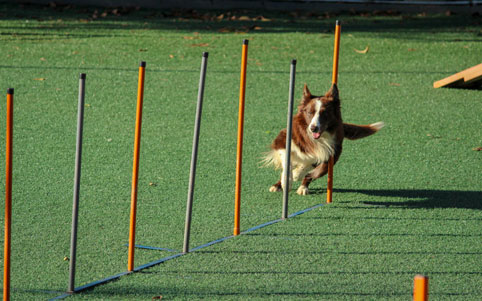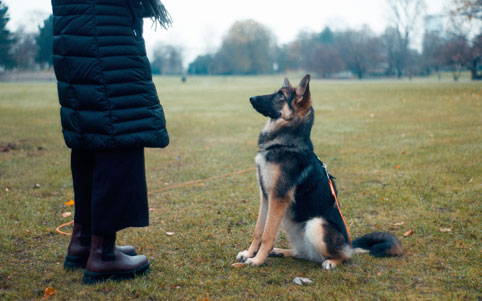If you’ve decided to start your own dog training business, odds are that you either have an existing dog-focused business, like grooming or day care, and training is a natural addition for you, or you’ve decided on dog training as a relatively low-cost business to start your career in working with animals.
You don’t need a shop or office to run a great dog training business if it’s going to be your primary job, and that eliminates some massive overheads.
You just need a decent amount of space where you can go with your dogs and owners to put them through their paces – from parks to some dog-friendly beaches, the choice is yours. And of course, you need to be protected with dog training insurance.
So what do you need to make your dog training business a success?
1. You need a business plan
As with any business, small or large, you’ll want at least a basic business plan. Your overheads will be low, but it’s still a good idea to get everything down on paper before you get started.
If you’re adding dog training onto your core business, you likely already drew one up for the initial business you started. This one won’t need to be as detailed, and you can draw on your experience and knowledge when putting it together.
If this is your first business, make sure you look at every possible cost. From qualifying courses to insurance, add each of these in and budget for them. Lay out an achievable timeline for your goals, and create check lists of what needs to be done before you start advertising your services.
2. You need people skills and experience with dogs
People start an animal business because they love animals. Most people who want to become trainers have trained their own pets, and likely a few of their friends pooches as well. That experience is going to be vital, because you’ll be dealing with a variety of dogs. Different species have different temperaments, and what works well when training one dog can fail badly with another.
If you can, try and get some further experience either by apprenticing with a practiced trainer, or at a shelter.
One of the things new starters in the industry overlook is how much time you’ll be spending with people.
A surprisingly large amount of dog training also involves training the owner. You’re going to need empathy and great conversational skills so that you can explain things to Fluffy’s mum without upsetting her. Training a dog once a week is great, but that dog spends all of the rest of its time with its human – and a human that doesn’t understand the training process is going to undo all of your hard work in the days between training sessions.

3. Insurance is vital
Working with animals means a certain amount of unpredictability. Add a varied mix of dogs and humans in close proximity, and the smart dog trainer knows that unpredictable things can happen.
There are two main types of insurance a dog trainer will want: public liability, which covers your legal liabilities to third party claims, and professional indemnity, which protects your business against client claims for loss or damage.
If you employ someone or have a volunteer working with you, you’ll need employers liability insurance as a legal requirement. That applies to any business, no matter how large or small.
4. Get qualified
ualifications in dog training aren’t a legal must, but they go a long way to reassuring your clients that you know what you’re doing.
There are courses available all over the country, and the prices and length of the course can range the spectrum of a couple of hundred pounds to a couple of thousand.
In a classic case of buyer beware, the priciest courses are not always the best. Shop around, check reviews, and speak to past students if you can before signing up.
5. Niche specialisation can bring more customers
Niche training like puppy socialisation, leash training, town walking and basic manners are all likely to bring you clients looking for those specific skills.
Pick a niche you’re comfortable in, and concentrate on that. If you have multiple skill sets, you can choose a couple of niches that you know will do well in your area.
If you’re just starting out, avoid niches like aggressive dog rehabilitation – the risks are high, and you are unlikely to get the doggy cuddles you’ve probably been thinking about. That area is best left to dog behaviourists to address.
6. Upskill to become a dog behaviourist
Once you’ve got some experience under your belt, you’ll probably be wondering about expanding your skill set.
Dog trainers teach the dogs to obey a set of commands. A dog behaviourist deals with the psychological behaviour of an animal. This is the expert people go to when Lassie gets unhappy with the bedding, tries to bite the postman, or pulls her own fur out.
It’s demanding work, but hugely satisfying. Dogs, like humans, can have a massive range of emotional problems that need help. Separation anxiety and food aggression are two big areas that behaviourists see a lot of, for example.
A good behaviourist can make the difference between a dog living a happy, healthy life, or trouble and aggravation when the owner can’t fix the behaviour.
7. You need a website
Word of mouth is the greatest advert you’ll get from happy clients. You need a website to go along with that, since most people will google you before they ever contact you directly.
You can either hire someone to write your website, or put one together yourself – there are some low cost site builders out there for you with really easy to follow instructions, from Wix to Squarespace. You’ll want something that lets you add a blog, your social media links, and pictures of your happy clients and their pups.
8. Get social
Social media is a must, even for a small business.
Find out where your average client is like to spend most of their online time, and make sure you have a business account in that space to advertise your dog training business. Whether you’re on Instagram, Twitter, or TikTok, regular posts and cute updates build word of mouth and a great fanbase.
Make sure you keep your business account and your private one completely separate, and avoid posting content that will get you the wrong sort of attention.
Going from 5 stars to 1 star on Yelp is achievable in a matter of hours, and some businesses never recover from that.

9. Tell everybody
Get a couple of business cards printed up and hand them out. A lot of local shops are happy to pin them up in the window or on a local business board for people.
Leafletting the neighbourhood is another excellent way to get the word out – just make sure you aren’t annoying people with no junk mail signs on the doors. Annoying your potential customers won’t get them to sign up with you.
If you’ve already got a doggy business, make sure you let your customers know about the new training option for their fur baby, and add it to your website. Offer promotions and referral discounts, and if you have a newsletter, make sure your new dog training business is front and centre for signed up customers to see on your next email, with a reminder every couple of months.
If you’ve already got a good relationship with local kennels and dog parlours, make sure to let them know you’re available. You can offer to work with them on courses, and doggy day-care is an ideal situation for in-house training on basic commands.
10. Be flexible and reliable
As a dog trainer, be prepared to work evenings and weekends, when the humans are available for the training sessions. You’ll need to decide whether you want to work on one-to-one or group basis or both, and how big any group is going to be.
Once you’ve committed to a day and time, make sure you turn up promptly. If you have an unavoidable personal emergency that means you won’t make it that week, make sure to notify your clients immediately.
11. Charge reasonably for your area
Do research on existing trainers in your area to get a good idea of what a reasonable charge per session is. Undercutting or overcharging are both going to do more harm than good; aim for a happy medium in price. As you gain experience and a good reputation, you can adjust your prices to match.
Dog training is a booming industry. With no regulations or legislation around it, becoming a dog trainer is one of the last true open markets for someone who wants to open their own business.
With the right preparation, you can have a great business that provides a much needed service to pets and their owner.